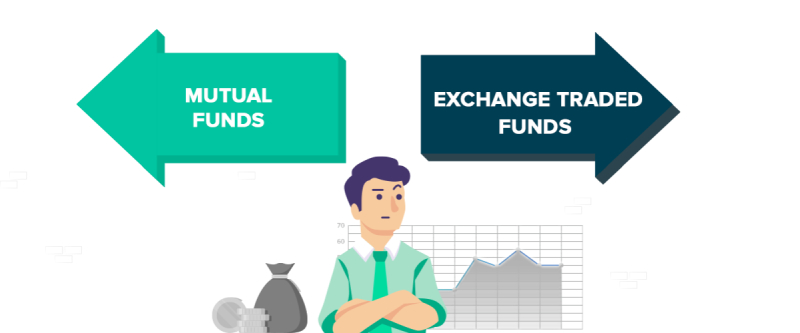
As interest in inactive investing keeps on grow, so does the variety of tracker choices accessible. While inactive speculations may all hope to do exactly the same thing, they can really be altogether different.
To assist shine with some lighting on aloof investing, we’ve featured a few contrasts between two significant gatherings of detached ventures, file assets and ETFs.
Investing isn’t appropriate for everybody. Investors ought to possibly contribute in case the ventures’ destinations are lined up with their own, and there’s a particular requirement for the kind of speculation being made. Financial backers ought to comprehend the particular dangers before they contribute, and ensure any new venture shapes part of an expanded portfolio.
What exactly are index funds and ETFs?
Both are passive investments that let financial backers access securities exchanges by following a basic file, similar to the FTSE 100. In any case, there are subtleties that different them.
At the point when you purchase or sell a file store, the cost depends on the complete worth of all protections held inside the asset, otherwise called the net resource esteem (NAV). Record subsidizes just worth and exchange one time per day, as a rule at noontime. In contrast to ETFs, financial backers will not know precisely the thing value they’re purchasing or selling for until after the exchange’s occurred.
ETFs then again are typically exchanged on a stock trade, similar to shares, and are a kind of Exchange Traded Product. They actually track a basic record, yet the cost of ETFs will vary through the exchanging day. While having the option to exchange ETFs for the duration of the day makes them more adaptable, it’s never a smart thought to attempt time the market – that is something not even the specialists can do.
List reserves are commonly single valued, which means the purchase and sell cost is something very similar. While ETFs have diverse purchase and sell costs, known as the proposition and bid separately. The distinction between the purchase and sell cost is known as the bid/offer spread. A little bid/offer spread means the financial backers are accomplishing a market value near the NAV. These spreads are overseen by market producers, an assigned merchant seller organization that tracks an ETF’s NAV for the duration of the day.
There can be events where an ETF’s market cost probably won’t coordinate with the NAV. In case the ETF’s market cost is over the NAV it is supposed to exchange ‘at a higher cost than expected’, beneath it would be known as a ‘rebate’. This doesn’t occur with file reserves. These value inconsistencies can happen when:
Markets are fluctuating all the more drastically (for example at market open or close)
The hidden possessions exchange inconsistently (for example securities or developing pieces of the pie)
The hidden possessions exchange at unexpected hours in comparison to the stock trade
How easy are they to trade?
At the point when you place a guidance to purchase or sell a list reserve, the interaction is administered by the asset chief and doesn’t need some other member on the lookout (an intermediary for instance). This typically implies that your exchange guidance is probably going to be acknowledged with no issues.
ETFs are exchanged like offers, so you’re depending on somebody in the market needing to take the opposite side of your exchange. While this is probably not going to cause any issues, during times of low exchanging action, you could run into troubles exchanging ETFs on the off chance that you can’t discover a purchaser/vender.
How much will they cost?
Both file assets and ETFs have yearly administration charges that are paid to the organization offering the speculation. Since they’re both inactive ventures, they normally have lower yearly administration charges contrasted with their effectively overseen partners (ones that attempt to beat a benchmark rather than track it).
Exchange costs for record reserves are zero on the HL stage, however this isn’t the situation for ETFs. As they’re dealt with and exchanged like offers, both a purchase and sell guidance for an ETF will be dependent upon the HL share managing charges. The distinction in managing charges can be a significant thought when choosing if a list asset or ETF is ideal for a portfolio.
Our foundation energize of to 0.45% per annum additionally applies for file reserves held in any record. This charge will likewise apply to ETFs held in a HL ISA (to a limit of £45 each year) and those held in the HL SIPP (covered at £200 each year). There’s no stage charge for holding ETFs in the HL Fund and Share Account.
Here’s a summary of the key points for investors:
| Index Fund | Exchange Traded Fund | |
|---|---|---|
| What do they track? | Underlying Index | Underlying Index |
| How do they trade? | Trade like a fund | Trade like a share |
| Pricing | NAV of the underlying investments | Bid and offer price based on underlying investments |
| When are they priced? | Once a day | Continually throughout the day |
| Trading costs | No dealing costs | HL share dealing costs (£5.95 – £11.95 per deal if done online) |
| Holding charge in a HL account | Up to 0.45% per annum | Up to 0.45% per annum (capped at £45 in an HL ISA and £200 in an HL SIPP). No charge for holding them in a HL Fund and Share Account |
| Initial investment | Minimum of £100 lump sum or £25 through the regular savings plan | No minimum investment. However must buy at least one share |
Disclaimer: The views, suggestions, and opinions expressed here are the sole responsibility of the experts. No journalist was involved in the writing and production of this article.

